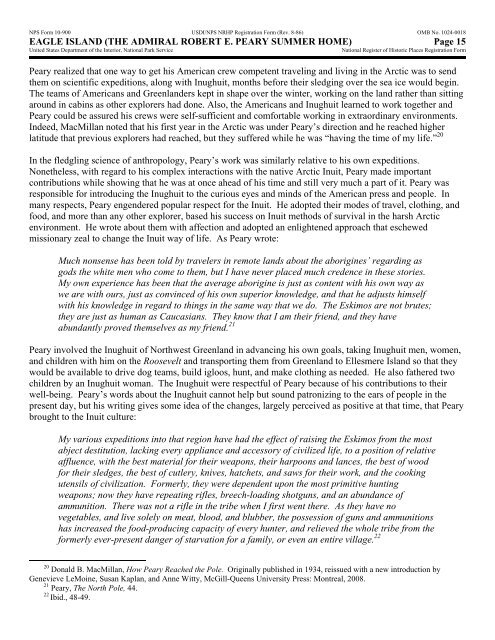Nomination - National Park Service
Nomination - National Park Service
Nomination - National Park Service
Create successful ePaper yourself
Turn your PDF publications into a flip-book with our unique Google optimized e-Paper software.
NPS Form 10-900 USDI/NPS NRHP Registration Form (Rev. 8-86) OMB No. 1024-0018<br />
EAGLE ISLAND (THE ADMIRAL ROBERT E. PEARY SUMMER HOME) Page 15<br />
United States Department of the Interior, <strong>National</strong> <strong>Park</strong> <strong>Service</strong><br />
<strong>National</strong> Register of Historic Places Registration Form<br />
Peary realized that one way to get his American crew competent traveling and living in the Arctic was to send<br />
them on scientific expeditions, along with Inughuit, months before their sledging over the sea ice would begin.<br />
The teams of Americans and Greenlanders kept in shape over the winter, working on the land rather than sitting<br />
around in cabins as other explorers had done. Also, the Americans and Inughuit learned to work together and<br />
Peary could be assured his crews were self-sufficient and comfortable working in extraordinary environments.<br />
Indeed, MacMillan noted that his first year in the Arctic was under Peary’s direction and he reached higher<br />
latitude that previous explorers had reached, but they suffered while he was “having the time of my life.” 20<br />
In the fledgling science of anthropology, Peary’s work was similarly relative to his own expeditions.<br />
Nonetheless, with regard to his complex interactions with the native Arctic Inuit, Peary made important<br />
contributions while showing that he was at once ahead of his time and still very much a part of it. Peary was<br />
responsible for introducing the Inughuit to the curious eyes and minds of the American press and people. In<br />
many respects, Peary engendered popular respect for the Inuit. He adopted their modes of travel, clothing, and<br />
food, and more than any other explorer, based his success on Inuit methods of survival in the harsh Arctic<br />
environment. He wrote about them with affection and adopted an enlightened approach that eschewed<br />
missionary zeal to change the Inuit way of life. As Peary wrote:<br />
Much nonsense has been told by travelers in remote lands about the aborigines’ regarding as<br />
gods the white men who come to them, but I have never placed much credence in these stories.<br />
My own experience has been that the average aborigine is just as content with his own way as<br />
we are with ours, just as convinced of his own superior knowledge, and that he adjusts himself<br />
with his knowledge in regard to things in the same way that we do. The Eskimos are not brutes;<br />
they are just as human as Caucasians. They know that I am their friend, and they have<br />
abundantly proved themselves as my friend. 21<br />
Peary involved the Inughuit of Northwest Greenland in advancing his own goals, taking Inughuit men, women,<br />
and children with him on the Roosevelt and transporting them from Greenland to Ellesmere Island so that they<br />
would be available to drive dog teams, build igloos, hunt, and make clothing as needed. He also fathered two<br />
children by an Inughuit woman. The Inughuit were respectful of Peary because of his contributions to their<br />
well-being. Peary’s words about the Inughuit cannot help but sound patronizing to the ears of people in the<br />
present day, but his writing gives some idea of the changes, largely perceived as positive at that time, that Peary<br />
brought to the Inuit culture:<br />
My various expeditions into that region have had the effect of raising the Eskimos from the most<br />
abject destitution, lacking every appliance and accessory of civilized life, to a position of relative<br />
affluence, with the best material for their weapons, their harpoons and lances, the best of wood<br />
for their sledges, the best of cutlery, knives, hatchets, and saws for their work, and the cooking<br />
utensils of civilization. Formerly, they were dependent upon the most primitive hunting<br />
weapons; now they have repeating rifles, breech-loading shotguns, and an abundance of<br />
ammunition. There was not a rifle in the tribe when I first went there. As they have no<br />
vegetables, and live solely on meat, blood, and blubber, the possession of guns and ammunitions<br />
has increased the food-producing capacity of every hunter, and relieved the whole tribe from the<br />
formerly ever-present danger of starvation for a family, or even an entire village. 22<br />
20 Donald B. MacMillan, How Peary Reached the Pole. Originally published in 1934, reissued with a new introduction by<br />
Genevieve LeMoine, Susan Kaplan, and Anne Witty, McGill-Queens University Press: Montreal, 2008.<br />
21 Peary, The North Pole, 44.<br />
22<br />
Ibid., 48-49.
















